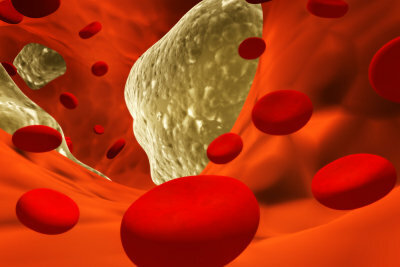First signs of thrombosis
When a thrombosis is mentioned, it usually refers to the occlusion of a vein by a blood clot, which usually occurs in the legs. If it is not recognized in time, it can trigger a life-threatening complication. The clot may travel up the body through the leg veins and travel through the heart to the lungs, where it can cause pulmonary embolism, which is accompanied by acute shortness of breath. It is therefore important to be able to recognize the first signs of a thrombosis at an early stage and to act accordingly. Here's how to do it.

First signs of venous occlusion
- Many thromboses are only slightly noticeable or not at all due to symptoms. Unfortunately, pulmonary embolism is often the first sign that a thrombosis has been present. However, when symptoms do develop, they are pretty clear.
- In most cases, one leg is affected.
- Depending on the location of the closure, the symptoms can be felt on the calf, the hollow of the knee or the entire leg.
- In the case of a thrombosis, the affected extremity turns red-bluish in color. At the beginning, this coloration can be weak.
- The leg is sore and tight.
- If you touch the leg and compare it with the healthy leg, you will notice a clear difference in temperature. The diseased leg is hot.
- The limb is swollen. This, too, may not be recognizable at first glance. Take a tape measure and measure.
- If you now suspect a thrombosis, call the emergency services as there is a risk of pulmonary embolism. Share the signs you noticed there.
- The affected leg or the affected poor hang up until you arrive pillow or something like that so that the extremity is elevated.
- It is important that the person concerned no longer walks, as the thrombus can loosen due to vibrations.
Thromboses are feared in humans. You appear after the immobilization of a ...
Causes of Thrombosis
A thrombosis can develop due to several causes.
- The composition of the blood has changed. This is possible through a coagulation disorder, which is congenital, acquired or also through Medication can be caused. Certain Diseases, Toxins, pregnancy and insufficient fluid intake also affect the ability of the blood to clot. The coagulation is increased or blood clots are broken down less.
- Due to varicose veins, external pressure on the veins (long sitting with crossed legs) or being bedridden, the blood flows more slowly and is therefore prone to thrombosis.
- From inflammation, Injuries or age-related changes in the veins, the wall of the vein is damaged. Even in this case, the blood cannot flow properly, it swirls up in the damaged areas and tends to form thrombosis.
- Other risk factors are the pill, smoking, Obesity and previous thrombosis.
How helpful do you find this article?
The content of the pages of www.helpster.de was created with the greatest care and to the best of our knowledge and belief. However, no guarantee can be given for the correctness and completeness. For this reason, any liability for possible damage in connection with the use of the information offered is excluded. Information and articles must under no circumstances be viewed as a substitute for professional advice and / or treatment by trained and recognized doctors. The content of www.helpster.de cannot and must not be used to make independent diagnoses or to start treatments.


